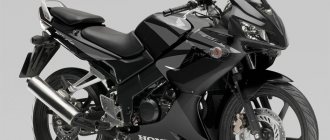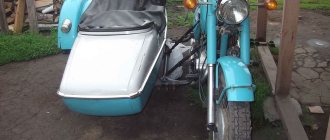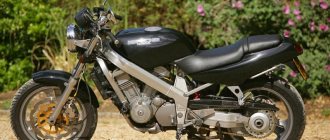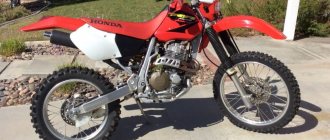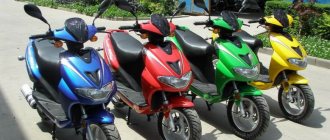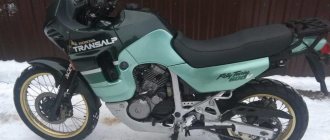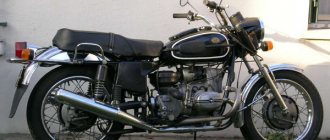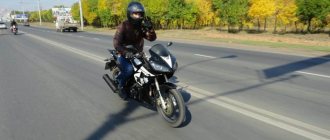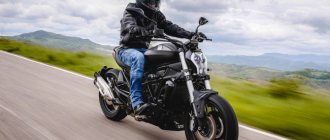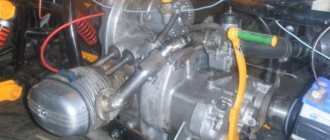Features of Honda CB 500
The bike was distinguished by low maintenance costs, predictability in any road conditions, and good maneuverability.
The Honda CB 500 is a fairly versatile motorcycle: a vehicle for daily transportation, on weekends to the country, and also capable of long-distance travel.
It was of the naked type, but had a modification with a large amount of body kit.
The main market for which the model was intended was Europe , so all dimensional characteristics were calculated for the average EU resident. The motorcycle was considered a road bike and allowed a classic landing.
In 2013, a model with the same name appeared at Honda factories based in Thailand, but it has .
The new CB 500 sold in the Russian Federation belongs to this Thai clone.
What's new in the 2021 Honda CB500X?
Honda adds “endurance” to the model without sacrificing road performance. They don't plan to knock Rally Raid out of the market by copying their kit and putting it on stock bikes, but many of the major changes in the new version are not far from the most popular mods of previous years.
Honda CB500X 2019
Firstly, the front 17-inch wheel was replaced by a 19-inch one. This improves obstacle passing without much impact on the CB500X's ride on pavement. There are a lot of road and touring tires available for the new size, which you can choose for specific tasks.
Another important news is the redesigned suspension: the front travel has been increased by 1 cm, and the rear travel has been increased by 3 cm. The stock 500X does not have crankcase protection, so ground clearance is important here. Both suspensions are adjustable for preload, and a new rear shock absorber better copes with difficult terrain.
As before, the 471 cc inline-two produces about 50 hp. (according to Honda Europe, because the American division does not publish horse data). But the 2019 version of the CB500X has slightly increased bottom-end traction, which is useful for both civilian on-road and off-road driving.
Other updates are more about aesthetics: all-LED lighting, which is quite nice, including a new headlight. The muffler is a little louder (but still very quiet) and allows the engine to breathe a little better. The new slipper clutch is even easier to engage than before (a lot of new Hondas have it, and I personally really like it). The body kit has been improved, and the new small beak looks very touching and flexible. Overall, the motorcycle gives the impression of an expensive and high-quality item.
It is quite comfortable to sit on: the seat height is 83 cm, and I can easily place my entire foot on it. The new steering wheel allows for a free, upright position, even more comfortable than at my desk.
Specifications
The engine definitely has the required minimum power reserve, but for sharp acceleration the engine has to be turned thoroughly.
The motorcycle engine did not say anything new in technology. This is a standard 4-stroke 2-barrel in-line design.
- Working volume - 499 cm3.
- Power - 57 hp
- Number of valves - 8.
- Cylinders - 2.
- Cooling is liquid.
- Fuel delivery is a 34mm Keihin carburetor.
- Ignition is electronic.
- Start - electric starter.
- Fuel tank - 18 l.
Transmission and clutch
The bike received a 6-speed gearbox.
Since she did not receive any negative feedback, they did not change the settings. The gears were designed so that after reaching the third most of the revolutions it was possible to adjust only with the throttle.
- Multi-disc clutch, oil bath. Power transmission is a cable .
- The main drive is a chain .
Brakes
Brembo front caliper on the CB500S.
Rear drum on CB500R.
Unlike many Japanese colleagues, the bike gets unusual brakes. Instead of the standard black Nissin, the front wheel has a gold Brembo brace,
Front: brakes:
- number of disks - 1;
- diameter - 296 mm;
- support - 2-piston.
Rear brakes:
- number of disks - 1;
- diameter - 240 mm;
- support - 1-piston.
According to the developers, Brembo was not planned. But with the release of the version with a fairing, which was positioned as more sporty, the usual ones turned out to be not enough. Nissin did not give the opportunity to “bite into” the asphalt. After the presentation of the version, users asked for the same ones for the basic configuration. Therefore, from the second generation, all bikes, of all modifications, work with Brembo.
Chassis and brakes
The bike is equipped with a steel duplex frame that looks great and is truly classic. It is as strong as a standard steering wheel with alloy wheels. In a word, reliability and style are felt in everything here.
The rear suspension is double shock absorber. Its stroke is 117 mm. At the front, the suspension travel is 115 mm; it is a telescopic fork with dimensions of 37 mm. At the rear, braking comes courtesy of a 240mm disc and single-piston caliper. The front brake is a 296 mm disc complete with a two-piston caliper.
Driving performance
Different publications indicate the maximum speed from 185 to 195 km/h.
However, according to users, both that and the second mark are underestimated. With a good high windshield, you can calmly and comfortably “fry” at 200 km/h. There is enough power.
Acceleration to hundreds
Acceleration from zero to 100 km/h is 4.3 seconds , which is quite normal for a road version.
But the situation with consumption is sad. An average cruiser will require up to 6–7 liters per 100 km.
With a tank of 18 liters, the bike’s autonomy is not impressive, but nowadays there are no problems with refueling. In this case, the motorcycle is usually refueled with 92 according to the instructions.
Pros and cons of the model
The advantages of the motorcycle include the following parameters:
- Dimensions.
- Comfortable fit for many.
- Good dynamics.
- Stylish appearance.
- Sufficient power.
- Low gasoline consumption.
- Reasonable price of spare parts and their availability.
- Low cost of repairs.
Among the disadvantages, it is worth highlighting the high mileage of motorcycles presented on the private market, as well as a slight discrepancy between the maximum speeds (declared and actual).
Dimensions and weight
With the exception of the weight, which increased first by 3 kg, and then by another 6, the remaining parameters did not change during production.
- Dry weight for naked - 170 kg .
- The same parameter for the version with a body kit - 176 kg .
The motorcycle had the following dimensions:
- length - 2081 mm ;
- width - 721 mm ;
- in height - 1051 mm .
- seat height - 776 mm .
- wheelbase - 1431 mm .
Honda CB500
I want to share with you information about the Honda CB500 - such a good, but not very common motorcycle in Russia. I started writing the article by describing the different aspects of using a motorcycle. And in the process I realized that the result was an article with rare information, which people who used the motorcycle only in city mode have no idea about, and which I would like to see in good review articles.
Under the cut there is some general information and then a lot (!) of specifics about using the motorcycle on the track and in gymkhana. A very simple and reliable motorcycle. In terms of spare parts and consumables, it is not much different from the CB400. Compared to the 400 it starts to pull earlier, but at the same time the engine is less revving, the cut-off is at 10.5 thousand revolutions. Market prices for this model are slightly higher than for the CB400, but the CB500 is a less popular option. The sound of the engine is not for everyone, very ragged and harsh, with a hoarseness.
Let's start with the frame; it is spacious, rigid and durable, which is why the model is popular in Europe among beginner stunters. The big disadvantage, in my opinion, is the fork with stays with a diameter of 37 mm. In case of problems with feathers, you will either have to search very hard in Poland at a disassembly site, or buy replicas. Since the model gained popularity only in Europe, Aliexpress does not spoil us with spare parts and goodies. The fork itself is very soft, very comfortable when traveling. Its disadvantage is that it is not regulated in any way. There are, of course, ways: selecting the length and stiffness of the spring at the same time as selecting the fork oil. But all this must be selected for a specific pilot by experienced people; there is a big risk of making things worse. Next, we continue the review from the front of the motorcycle. We have one brake disc, in terms of daily use this is definitely a plus, the savings on pads are enormous. Pointer instrumentation, speedometer cable drive. Be careful, the cable should not be twisted, as it can be accidentally broken. And you’ll have to look at the dashboards of cars walking nearby. Two panels: speedometer with odometer and tachometer. The odometer is reset by a wheel and serves as a guide to determine when to turn into a gas station. If you suddenly stall on a bend, you can easily open the reserve valve on the left under the gas tank to get to the gas station. In addition to the rare-diameter stays, we have plastic trims that extend from the tank and attach to the radiator. Just like the feathers, this part is always a problem. A more or less adequate option in terms of price/quality is a used one on the Polish site allegro. Let's move on to the rear suspension, it is quite soft. And in trying to make it tougher, we simply lift our tails, which, in fact, does not help much. I would like to note that access to the spark plugs is quite simple; the tank can be removed very easily; two keys are enough to unscrew one nut and remove the bolt. Also a big bonus is the huge glove compartment, like a Volga trunk. Where, I’ll tell you a secret, one and a half liters of liquid fits. And I immediately give advice: you need to take liter and half-liter bottles. At the same time, the minimum supply of tools also fits there without any problems (I have a repair kit for cables, a repair kit for tires, a screwdriver, an adjustable wrench, and pliers). The remaining details are best viewed in person. The motorcycle doesn't fly, but it rides briskly.
CB500 in Gymkhana
I want to say right away that for me this is the best motorcycle for gymkhana training. In terms of preparing a motorcycle for this sport, I will only note the need for a cage. Moreover, the cage on the Honda CB500 is not very popular, so the best option is to make it yourself or to order. Our fork is very soft, so pay attention to the rubber, it should be of good quality and provide grip, not fat. The idle speed adjustment is located under the carbs; with my 172 cm, I was able to turn up the speed at a traffic light without straining. Therefore, there are no problems with adjusting the XX on the site. Now let's take a closer look at the cell. Initially, the goal was simply to protect the engine covers. Season 2015 In the 2015 season (the first) it was scary to fall somewhere and lose money. The cage was originally made in the same workshop.
Through the engine protection, the moto rolled safely onto the tank-grip-turn signal and especially caught with the rear left plastic of the tail. After one lucky fall, when a car caught up with me in front of a pedestrian crossing, the cage shifted on the fastenings (on each side there are two U-ties on the frame and one full fastening to the frame and engine, tightened with an axle across the frame). As it turned out, the U-shaped bolts with 15 nuts... There was also a moment that the cage was clinging to the asphalt with its convex lower parts. Season 2021 Next season, the protection was tasked with falling at low speeds without losses or abrasions. Plus some kind of safety net for extra security and the track.
Unfortunately, the CB500 frame only has one proper mounting point on each side. To prevent the bike from tipping over the cage, we raised the support point on the asphalt as high as possible. The slider rests on three pipes from the cage for rigidity + a jumper connecting the two halves of the cage to each other. This jumper goes over the cylinder head cover, it’s scary, but this jumper can only play well along it, and not towards it. It is quite suitable for the given tasks. Also, the convex pipe of the cage, which clung to the asphalt, was welded straight. The second edition of the cage was made by our Rostov craftsman.
CB500 on the track
At the end of my first season, I found videos of the Promo 500 championship on YouTube, where mainly CB500s compete, and became obsessed with the track. The CB500 is a road bike, so it comes to the track with modifications.
Personal experience on the track
You can ride and roll on it.
At a good pace and sessions no longer than 15-20 minutes, there are enough brakes (the track is about 1200-1400 m, my maximum speed is about 100 km/h). However, if you try to use the brakes at 100% (when the front tires start to sing - braking using maximum grip), then boiling is possible. There was an incident, but fortunately I just drove right through the track on the grass (after only two laps of good braking). As advised, I filled in sports brake fluid. But since life is precious, I didn’t slow down so harshly anymore. Regarding traction, everything is simple, you need to keep the speed at least 5 thousand and then at any moment all the traction of the motorcycle is in your hands. Since I overhauled my engine, it had no mercy on the track, and entry into the turn usually occurred at 5-6 thousand.
About the angle. I had a cage with the lower parts raised as much as possible so as not to interfere with the tilt. This is enough for a Sibihi by itself, but when you get involved with one of the sportsmen, there are problems. There are plug turns (180 degrees or more), where the optimal passage is to brake deep into the turn, where you already give the maximum angle and exit at the inner edge (this way you can start opening the gas as early and sharply as possible). But! This does not work on the Sibikha. The angle is not enough and you have to take the average trajectory and go through the entire turn on the step.
In general, in fast corners where you don't need a lot of lean, everything is fine. Of course, it’s unlikely that a normal racer on a 600 will be able to pass, but scaring the majors on beamers by overtaking along the inner radius with the terrible noise of a collective farm direct flow is like two fingers. 
The following is a list of improvements based on the article I found and translated (I don’t publish the link, but I can give it if necessary) and personal experience. Unfortunately, I didn’t have a chance to use any of the above, as I compared this list with buying another motorcycle and chose the second one.
1) Footrests
Drawing (below) of the footpeg brackets to raise them higher. Drawing from the Internet from an article about preparing a 500 for racing. Or the footrests can be filed down by 1-1.5 cm. Or moved higher and back. Aluminum welding required.
2) Exhaust
Will inevitably cling. Either lift up the can or install a damper. Ideally, change the exhaust completely to a lighter one with a higher manifold (examples were given in the article: Leo Vince, Micron).
3) Central and side steps
needs to be removed.
4) Stars
14x41 or 14x42 are recommended (original 15x40).
5) Protection
The side covers are protected with special Kevlar pads. Slider on the axle, damper on the muffler. Regarding the linings for the engine covers, you can buy them (I don’t know where or how much), or you can make them from fiberglass (or even better, carbon fabric).
6) Rubber
Stock kit 110-80/17 and 130-80/17 The table below lists the possible options tested in the Promo 500 race.
A smaller profile means a smaller maximum lean angle; the narrower the tires, the better the handling. It is also worth considering that the sides of the rubber are softer, and by installing a wider set you lose a little grip. But all this requires testing in practice. In fact, a prepared motorcycle (the side and center steps have been removed, the exhaust has been raised, the driver's footpegs have been raised) already allows for a good angle, so you can put 70 profile tires or even 150/60 on the rear.
7) Suspension
Unfortunately, the motorcycle was not originally intended for racing, so the front suspension is not adjustable, and the rear has only one setting. Front In a good way, you need to select other springs for your weight + select fork oil, taking into account that when the suspension is active, the oil heats up very well and can change its properties. It is written that you can fill it with 20W, and after active work it will become liquid like 15W. In addition, the front end can be raised or lowered by relaxing the crossbars and moving the stays up or down. Rear It is possible to adjust the rigidity, it is recommended to put it in a “harder” position. Since everything is designed to absorb unevenness on the road, and at a sporty pace the motorcycle will sway very much - hang on. You can use shock absorbers from other manufacturers (the article lists Fournales, EMC, Bitubo, Ohlins, White Power, Koni).
 Brakes
Brakes
There is no need to skimp here. You need to start by replacing the hoses with reinforced ones. You should use only high-quality pads (life depends on this, after all). The article I used recommended the following manufacturers and models: Carbone Lorraine C42, AP Racing LMP274SF, SMEC Brembo, SBS. On my own behalf, I’ll add that the main criterion is that they are not made in China; the pads must match the markings and be intended for use in sports (on the track, not to be confused with motocross). The brake discs must be replaced with floating ones. There is unconfirmed information that the brake discs will fit on the CBR600 without modifications.
9) Air filter
For greater performance, you should install a K&N zero (by the way, it is available specifically for the CB500 on the wemoto website). As far as I understand, it is installed in the same housing as the stock air filter, I could be wrong. The article says that when changing the filter, thrust increases in the region of 6-7 thousand revolutions, and reaching the red zone happens later. Also mentioned is a certain Unlimited Power kit (apparently some kind of air filter), which is the best option. Below is a photo of such a kit from the Internet.
And this is what the device looks like after preparation for the track.
CB500 on the road
But that's not all! This wonderful device is also capable of providing unforgettable experiences on the road. In 2015 there was a complete trip to Crimea, perhaps this will be the topic for one of the following articles. That’s all I have for now, but you can take a peek at part of this journey according to my partner’s version on the Crimean trip.
The information is based on personal experience and rare articles, collected bit by bit on the Internet, mainly in English- and French-language forums.
There is data on preparing a motorcycle for stunting, there is experience in long trips, engine repairs (selection of connecting rod bearings with translation of the manual).
For whom is it intended?
The Honda CB 500 is a prime example of what a road bike should be. Not the fastest, not the most touristy, just good and reliable.
Positioning the model only for Europe led to an interesting effect.
The ratio of the footrests and the height of the saddle, handlebars and glass allows users of any size and configuration to consider the purchase.
Brief history of the model
- June 2013 - start of production and sales of Honda CB500X.
Model
: Honda CB500X;
Honda CB500X ABS (all regions). Factory designation
: CB500XD; CB500XAD.
- 2014 - no significant changes.
Model
: Honda CB500X;
Honda CB500X ABS (all regions). Factory designation
: CB500XE; CB500XAE.
- 2015 - no significant changes.
Model
: Honda CB500X;
Honda CB500X ABS (all regions). Factory designation
: CB500XF; CB500XAF.
- 2016 - restyling of the model. The motorcycle gets updated exterior styling, LED headlight and brake light, taller windshield, adjustable front suspension and front brake lever. The fuel tank capacity increases: 17.3 l -> 17.5 l.
Model
: Honda CB500X;
Honda CB500X ABS (all regions). Factory designation
: CB500XG; CB500XAG.
- 2017 - the model receives a new exhaust system. The engine complies with Euro-4 environmental standards.
Model
: Honda CB500X;
Honda CB500X ABS (all regions). Factory designation
: CB500XH; CB500XAH.
- 2018 - no significant changes.
Model
: Honda CB500X;
Honda CB500X ABS (all regions). Factory designation
: CB500XJ; CB500XAJ.
- 2019 - restyling of the model.
Model
: Honda CB500X;
Honda CB500X ABS (all regions). Factory designation
: CB500XK; CB500XAK.
- 2020 - no significant changes.
Model
: Honda CB500X;
Honda CB500X ABS (all regions). Factory designation
: CB500XL; CB500XAL.
- 2021 - no significant changes.
Model
: Honda CB500X;
Honda CB500X ABS (all regions). Factory designation
: CB500XM; CB500XAM.
- 2022 - restyling of the model. The motorcycle received an inverted Showa SFF-BP fork and a double-disc brake system at the front (instead of one 320 mm disc, two 296 mm discs were used).
Model
: Honda CB500X;
Honda CB500X ABS (all regions). Factory designation
: CB500XN; CB500XAN.
Modifications
Officially, the bike received only one modification.
The modified version was sporty in nature and visually different from the base model.
Honda CB 500 S. The last letter meant sport . Version with front fairing, square headlight, large stock glass and sport inscriptions on the side skirts. Production began in 1998. Before the closure, the model was developed in parallel.
Thailand
Honda CB 500 R.
Honda CB 500 X.
Honda CB 500 F.
The Thai representative office of Honda presented a reincarnation of the model in 2013. Despite the same nameplates and design, the motorcycles have different fillings.
- Honda CB 500 R - reincarnation for the S version. Sports. New motorcycles of this configuration are available in the Russian Federation.
- Honda CB 500 X - enduro-tourer.
- Honda CB 500 F is a reincarnation of the basic version. Naked.
Test and details of Honda CB500X 2021
Honda CB500X 2019
On the road, the Honda CB500X is neutral, predictable and composed. The windshield does not block your view, and when you look down, you see a convenient digital instrument panel. The six-speed gearbox shifts easily and crisply, and what makes it even better is the light-squeeze clutch. Although the CB500X engine is flexible, it is still only half a liter, so you have to shift often.
Work with the gas the way you like: the motorcycle will respond clearly and calmly. It simply increases revs and speed without any fuss. The engine is not nervous or jerky, has no dips, the throttle is soft and smooth without being overly sensitive. The CB500X engine is tuned for smooth low-end pull and linear growth in the midrange and top-end. In some ways the bike is reminiscent of a small Africa Twin in terms of smooth traction. This is understandable because many owners of the new 500X will want to purchase an Africa Twin in the future.
Thanks to the wide handlebar, the Honda CB500X is very responsive on narrow roads. Get ready, apply pressure on the handle to push the 500X into the turn, the low end will help on the exit, and you're ready for the next thing. The origins of the road builder are quite noticeable - and that’s great. The front brake works great and has an adjustable lever. The rear has been updated, but is still a little lacking on the asphalt. ABS is available as an option, and once it is installed, it cannot be disabled. Rally Raid sells a kit to make the ABS switchable, but most users won't need it; the CB500X isn't for places where ABS would be a problem.
On the highway the bike rides as it should. Of course, a passenger or large luggage may slow it down somewhat. The windshield has two positions, and mine was in the upper position, in which it removes almost all the air flow from the chest and neck (I am 180 cm tall, and I would like a slightly higher windshield so as not to blow into the helmet). At high speeds, the inline-two vibrates slightly, like many others. Rubber-coated footpegs and handlebar mounts reduce vibrations, and only a test drive will show how important they are for you.
Honda CB500X 2019
About wheels
The Honda CB500X comes stock with Dunlop Trailmax Mixtour, quite obviously for the road. But I haven’t experienced them myself, and I have nothing to tell about them. Our test 500X, however, was shod with the Bridgestone Battlax AdventureCross AX41 for serious off-road riding. These big knob tires are significantly different from stock rubber. I really liked the way they looked on the CB500X, and I liked the way the bike handled them even more.
However, you shouldn’t forget that they are not purely road wheels, and you shouldn’t expect them to hold sports tires. Choose tires based on where you'll be driving.
Flaws
It’s interesting that only those who drove with the second number could appreciate the shortcomings - unsuccessful footrests for the passenger.
The metal bends, and when turning, the leg can slip.
The same footrest that can bend.
and dignity
But everyone appreciated the advantages:
- classic landing;
- the suspension is moderately stiff and licks up bumps well;
- ease of maintenance.
As always, Honda's reliability, comfort and safety are added.
